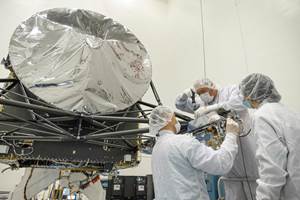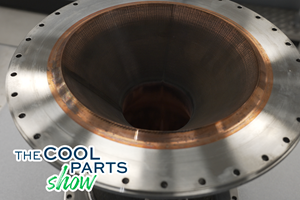6K Additive, Agile Space Industries Partner to Advance Moon Mission
6K Additive’s Nickel 625 powder is being qualified for use in Agile’s A2200 engine to leverage additive manufacturing for engine lightweighting while also delivering tremendous power.
6K Additive and Agile Space Industries are pursuing certification of 6K Additive-produced Ni625 powder for customer space applications including critical rocket parts. 6K Additive is a a division of 6K Inc. and a provider of sustainable materials for additive manufacturing (AM), while and Agile Space Industries is an in-space propulsion specialist.
6K Additive’s Ni625 powder is being certified for use at Agile’s manufacturing facility. The first parts to be produced will be used in Agile’s A2200 bipropellant hypergolic engine. The engine is powered by a pressure-fed hypergolic bipropellant, which does not require ignition as the hydrazine derivative fuel M20 and MON3 oxidizer combust on contact. Leveraging AM, the engine was designed to weigh just 5.9 kg and produce 500 lbs of thrust, underscoring the benefits of lightweighting with AM while delivering tremendous power.
“By weight, 85% of our engine components are additively manufactured, meaning we rely heavily on AM powders that can withstand the extreme temperatures and forces generated during takeoff and flight. 6K Additive allows us to additively manufacture using high-quality powders that are required for our critical applications, while also helping us meet our environmental goals through their recycling program and sustainably manufactured powders,” says Kyle Metsger, director of additive technology at Agile. “6K Additive can deliver extremely consistent powder that allows our production line to run the long build times required for these complex components.”
Traditional development cycles for aerospace components can be more than two decades. However, by harnessing the speed and flexibility of AM, Agile is able to compress development time down to 12 months. “A year-long development cycle still sounds like a very long time in many industries, but we are showing the primes in the aerospace industry what the future looks like,” Metsger adds. “Moving to the larger TruPrint 5000 machine gave us the ability to qualify the new parameters for the machine and material simultaneously. In this way, AM allows us to be ‘Agile’ in name and practice.”
Agile’s A2200 engines will be used on a Lunar lander vehicle. The A2200 engine was developed to provide maximum performance on demanding missions, with a specific impulse of more than 318 seconds. Using an integral pintle sleeve throttling mechanism, the engine is capable of deep throttling, providing a smooth ride and fine control for a variety of missions. The engine can throttle from 50 to 100% thrust in under 650 milliseconds, making it the perfect engine for heavily demanding maneuvering sequences that lunar missions require.
“We are always excited to partner with customers like Agile who leverage our high-quality powders to produce critical rocket parts to land on the moon,” says Frank Roberts, 6K Additive president. “The fact that we can enable space exploration while continuing to lead the way with sustainability at home on Earth is the best of both worlds. Agile has a cradle-to-grave mentality around its products, and having 6K Additive supply the company with high-quality, sustainably produced Ni625 and provide an established waste stream to help with its environmental stewardship speaks to our mission of going beyond expectations for our customers.”
- Learn about Morf3D and 6K Additive qualifying metal powders for aerospace customers. 6K Additive’s sustainably produced powders will be qualified for full industrialization and high-volume production.
- Read about 6K’s efforts to make the U.S. self-sufficient in aerospace alloy metal powders. 6K’s technology can upcycle titanium and nickel-alloy parts into additive manufacturing powder. Here is how the circular economy helps national security.
Related Content
Reusable LOX/Kerosene Engine Completes First Successful Full-System Test Flight
Galactic Energy Space Technology announced the first successful full-system test flight of its Welkin 50-ton reusable LOX/kerosene engine. To date, this is the highest thrust LOX/kerosene engine in the Chinese commercial aerospace playing field which has officially entered the engineering and manufacturing phase.
Read MoreZenith Tecnica Manufactures 3D Printed Hardware for NASA Psyche Mission
The node components designed by Maxar Space Systems were well suited to the advantages of EBM AM due to their complex geometries.
Read MoreSintavia Develops Niobium Printing Technology for Aerospace, Defense
C103 material parameter specification is said to enable full alloy adoption across defense and space applications.
Read More3D Printed NASA Thrust Chamber Assembly Combines Two Metal Processes: The Cool Parts Show #71
Laser powder bed fusion and directed energy deposition combine for an integrated multi-metal rocket propulsion system that will save cost and time for NASA. The Cool Parts Show visits NASA’s Marshall Space Flight Center.
Read MoreRead Next
Looking to Secure the Supply Chain for Castings? Don't Overlook 3D Printed Sand Cores and Molds
Concerns about casting lead times and costs have many OEMs looking to 3D print parts directly in metal. But don’t overlook the advantages of 3D printed sand cores and molds applied for conventional metal casting, says Humtown leader.
Read MoreVideo: Intelligent Layering Metal 3D Printing at 3DEO
Contract manufacturer 3DEO delivers metal parts using Intelligent Layering, a binder jetting-like 3D printing process the company developed and operates internally. Here’s how it works.
Read More3D Printing Brings Sustainability, Accessibility to Glass Manufacturing
Australian startup Maple Glass Printing has developed a process for extruding glass into artwork, lab implements and architectural elements. Along the way, the company has also found more efficient ways of recycling this material.
Read More











.png;maxWidth=300;quality=90)












